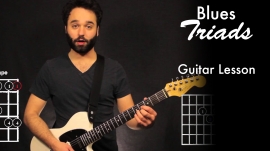This is a basic rundown of a simple way to find what the relative minor or major is. How is this useful? To see how and what chords, scales and arpeggios are similar.
4th finger on the major – a finger to a fret – 1st finger is your relative minor
1st finger on the major – a finger to a fret – 4th finger is your relative major
Take a look and compare the scales (and pentatonics) of these sets.
C major – A minor
G major – E minor
With a skipping strings these sets also work:
E major – one fret lower than the E major root note – D minor
A major – two frets higher than the A major root note – G minor
D major – two frets higher than the D major root note – C minor
-Related Lessons-
0:03 – How to Practice and Apply CAGED Chords | CO 9/10
PDF’s
CAGED Scale Shapes, CAGED Pentatonic Scale Shapes, CAGED Chord Shapes, CAGED Arpeggio Shapes, Relative Minor Worksheet & Relative Minor Worksheet (Answers)




